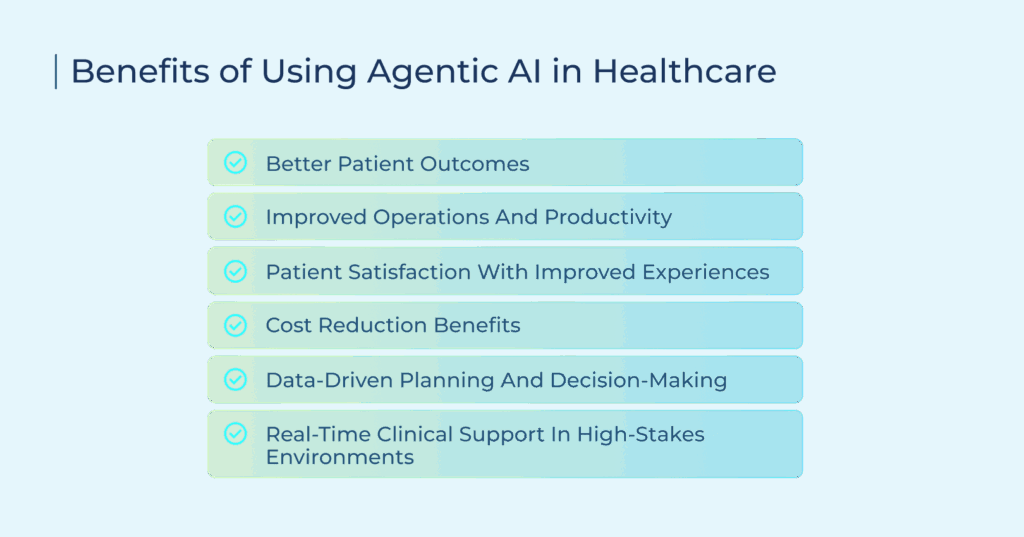Last flu season claimed the lives of more than 200 children in the United States,…

Agentic AI in Healthcare: Applications, Benefits & Challenges
What happens when AI doesn’t just assist but acts? Healthcare is already shifting under the weight of automation, but agentic AI takes it further. These systems don’t wait for commands. They analyze, decide, and initiate actions within defined guardrails. From triaging patients in real time to optimizing care plans without human prompting, agentic AI is redefining how care is delivered.
In this article, we’ll break down what agentic AI actually means in a clinical context, where it’s being used today, the measurable benefits it’s driving, and the regulatory and ethical friction points that still need to be addressed.
What’s an Agentic AI?
Agentic AI is a different breed when it comes to automated solutions. While it takes actions without human oversight, an agentic AI can actually evaluate situations and adapt itself based on outcomes.
Think about how ChatGPT generates content and DALL-E generates images. Both require human direction for each task. Agentic AI, however, operates differently. It can set goals, make plans, and execute tasks independently. It learns from each result and evolves accordingly to improve future results.
Consider customer service scenarios. Traditional systems route calls based on keywords. Generative systems create responses from templates. Agentic systems analyze the entire customer situation, decide on solutions, take action across multiple platforms, and follow up to ensure resolution.
The key difference lies in autonomy. Agentic AI doesn’t wait for instructions. It identifies problems, develops solutions, and implements fixes on its own.
Agentic AI in Healthcare
Medical care encompasses a lot of complicated situations in which autonomous agentic AI systems can step in. Their independent, goal-oriented style allows the AI to track patient experiences and data streams, spot issues and red flags, and act accordingly.
For instance, consider a patient whose vitals are showing early warning signs. The agentic AI will not just send an alert to the staff. It will also schedule follow-ups, adjust treatment protocols, and coordinate between departments, all within established healthcare protocols.
In such other instances, the AI might even suggest treatment solutions based on symptoms, medical history, present medications, etc.
This combination of autonomy and intelligence makes agentic AI a perfect collaborator for healthcare organizations. They are extremely effective at decreasing administrative workload, enhancing interdepartmental communication, and enhancing patient engagement.
Applications and Use Cases of Agentic AI in Healthcare
Healthcare providers utilize agentic AI in clinical and administrative operations to manage patient interactions, analyze medical information, and juggle complex workflows without continuous human monitoring. Below are some of the most prevalent use cases.
Clinical Decision Support and Diagnostics
Agentic AI can improve clinical decisions by suggesting real-time diagnoses and treatment options. It will analyze the patient’s symptoms, lab results, medical histories, and cross-reference them with hundreds or thousands of similar patient cases before providing diagnostic suggestions based on their best health outcomes.
While medical professionals are still the sole decision makers, receiving a feed of possible drug interactions and risk factors helps doctors take necessary precautions and steps faster.
Intelligent Patient Engagement Through Virtual Agents
Healthcare organizations let virtual agents handle routine patient communications without any human involvement. Powered by agentic AI tech, these virtual assistants help manage appointment reminders, prescription refills, common post-visit questions, etc. This AI-driven patient engagement only improves with time as the agentic AI starts personalizing communication based on its past responses and deliveries.
Some providers have also started using agentic AI assistants to conduct symptom assessments. Patients describe their symptoms through text or voice, and the system asks follow-up questions to narrow down potential causes.
Remote Monitoring and Chronic Care Management
Agentic AI can monitor data streams from wearable devices and mobile apps to help remote patients. Healthcare organizations are using this tech to treat patients who cannot make regular clinical visits, such as the elderly.
So, let’s take a diabetic patient as an example. They can continue streaming their blood sugar levels from home, and the agentic AI will automatically adjust their insulin settings based on necessity.
Heart failure patients use devices that monitor weight, blood pressure, and activity levels. The AI identifies patterns indicating fluid retention or declining cardiac function. It adjusts medication schedules and contacts care teams when hospitalization may be necessary.
Administrative Workflow Optimization
Pretty much every administrative task can be automated with agentic AI to let the staff focus on things that matter. Appointment scheduling? The AI will consider the availability of the doctor, procedure needs, and other requirements. It will even coordinate with multi-provider visits to give the patient enough time to prepare between procedures.
Claims processing, a highly tedious task, becomes easier since the AI can review medical codes, check policy coverage, flag potential fraud, and do more within seconds what would normally take a human minutes or hours.
This automation for every task not only cuts down on delays and errors but also frees up administrative staff for higher-value work.
Medical Imaging Analysis and Enhancement
We’re living in the future. Major healthcare organizations are already using agentic AI to review medical images like X-rays, MRIs, and CT scans. They will enhance the image quality, identify and label anomalies, and suggest the next course of action for the doctor to consider. This autonomous process improves the overall accuracy because the AI just might catch early signs of a disease that might avoid a doctor’s oversight.
To further note how agentic AI is assisting in medical images, mammography screening involves AI analysis of breast images for cancer indicators. The system identifies suspicious areas and calculates risk scores.
Similarly, CT scan analysis sees the AI measure lesion sizes, tracks changes over time, and compares findings to previous scans. It generates structured reports with quantitative measurements.
Personalized Treatment Plans
With agentic AI coordinating between multiple departments, it enables the provider to personalize treatment plans for every patient. This is based on the patient’s existing data as well as various factors that might be unique to each patient.
For example, mental health patients can have varying psychological issues, which the AI can identify to tailor their next steps. This ensures that treatments remain relevant and effective.
Benefits of Using Agentic AI in Healthcare

Unlike basic automation tools, agentic AI systems adapt to changing conditions and handle complex scenarios without constant human oversight. The impact extends beyond individual patient interactions to reshape how entire healthcare organizations operate.
Better Patient Outcomes
Your agentic AI systems are always analyzing patient data, catching early warning signs, most often before symptoms appear. Since they can cross-reference hundreds of medical factors and data streams, including medical papers, for a single patient, healthcare organizations can intervene earlier with personalized treatment plans with higher accuracy. Emergency departments using AI triage systems, for example, see fewer diagnostic errors as a result. This precision approach reduces trial-and-error treatment periods.
Improved Operations and Productivity
Healthcare workflows accelerate when agentic AI systems handle routine administrative tasks. Staff scheduling systems predict patient volume and adjust assignments accordingly. Nurses spend more time with patients instead of filing paperwork or tracking down information.
The same work efficiency hits all the other departments as well. OPDs clear backlogs faster. Bed management systems track patient flow throughout facilities, predicting discharge times and optimizing room assignments. Supply chain management becomes predictive rather than reactive, all without hiring or training additional staff.
Patient Satisfaction With Improved Experiences
Healthcare organizations see faster response times across the board with agentic AI systems. Patients receive immediate answers to routine questions about test results, appointment scheduling, and medication refills. Hence, they know exactly when to expect their appointments, lab results, and procedure scheduling. Even better, the AI updates patients automatically when delays occur, reducing anxiety and improving communication.
Cost Reduction Benefits
Continuing with another major benefit, agentic AI significantly reduces readmission rates. The AI identifies warning signs through remote monitoring devices and schedules interventions before conditions worsen.
This predictive scheduling lowers staffing costs and enables providers to optimize their resource allocations. Hospitals avoid both understaffing penalties and expensive overtime premiums. Medical errors also decline when AI double-checks prescriptions, treatment plans, and diagnostic interpretations.
Data-Driven Planning and Decision-Making
For healthcare organizations, the biggest benefit of using agentic AI is the shift from estimated to precise resource allocation. With the AI continuously analyzing patient flows, seasonal health trends, and community demographics to predict future needs, providers can make informed decisions in advance and be better prepared.
Hence, your standard performance metrics immediately become actionable insights. Bottlenecks are flagged and removed. Budget forecasting improves. Major capital investments and service expansions are done with greater confidence.
Real-Time Clinical Support in High-Stakes Environments
Emergencies require split-second decisions based on complex medical data. AI agents process patient information instantly, providing treatment recommendations while medical teams focus on procedures. This is a big win for trauma centers. The AI can monitor several patients at once, warning staff of small changes that signal worsening conditions. This instant feedback avoids complications, particularly during operations, and accelerates recovery times.
How to Address Agentic AI Challenges
As smart and autonomous as they are, agentic AI systems bring several challenges for healthcare organizations. Understanding these barriers and their solutions helps leaders avoid common pitfalls while planning ahead.
Data Privacy and Security
Healthcare organizations are a prime target for cyberattacks. Patient information is a goldmine on the black market, and with agentic AI systems requiring access to vast amounts of patient data to function effectively, providers are potentially creating additional security vulnerabilities.
Healthcare organizations can address these risks through end-to-end encryption that protects data both in transit and at rest, role-based access controls that limit system permissions to essential personnel only, and zero-trust security architectures that verify every access attempt.
Integration Challenges
Most healthcare organizations operate on legacy systems built decades ago, creating significant barriers for modern AI implementation. Instead of spending a portion of their annual budget to just maintain outdated systems, healthcare organizations can overcome these technical barriers through APIs. These serve as a bridge between old and new systems. They also create modular AI solutions that work alongside existing workflows rather than replacing them entirely.
Change Management
It’s no secret that the era of AI has everyone stressing about their current jobs. The front-desk staff might feel they are being replaced, while nurses might worry about the AI questioning their judgment.
Healthcare organizations can address this challenge through transparent communication. Inform the staff about the AI’s role. Explain how it’s only to be used as a support tool, and not as a replacement. There can also be training programs to build confidence with new AI systems. These show employees first-hand how they can become more efficient with AI tools.
Regulatory and Compliance Issues
HIPAA remains the core standard for protecting patient data, and any AI system that handles protected health information must meet its requirements. Sure, compliance means avoiding hefty penalties, but it’s also a direct signal to patients that their information is being handled responsibly.
However, the adoption of agentic AI brings added complexity. These systems must also align with broader legal frameworks, including the HITECH Act, FDA regulations for software as a medical device (SaMD), and emerging policies around AI governance. Ensuring compliance across these layers means going beyond traditional data security measures.
Healthcare organizations must make sure to involve their legal, compliance, and IT teams from the start. Schedule regular assessments and audits throughout the AI lifecycle. This helps beat evolving regulations and stands for the responsible use of AI in healthcare.
Overcoming Patient Skepticism Toward AI in Care
It’s not just employees; even patients can often be wary of interacting with AI in healthcare. They have fears of receiving reduced care quality, which is not unfounded. Even the most tech-savvy patients would still prefer speaking with an actual human professional, and not having their case dealt by an AI system.
Healthcare organizations can curb these fears and resistance through clear communication. Patients should be educated about what an agentic AI does. They will feel more comfortable after knowing that the final decision rests with their doctors.
What Does the Future Hold for Agentic AI in Healthcare?
The future of agentic AI in healthcare promises a massive shift from reactive tools to proactive systems across three major fronts.
Firstly, we have voice-driven agentic AI with the capacity of delivering emotional support to elderly patients, combating loneliness. Advances are being made on a new “empathy engine” as well to autonomously manage discharge guidance and medical adherence.
Secondly, with the rise of cloud-based frameworks, healthcare organizations are deploying specialized concierge agents on demand, integrating real-time EHR data, wearables, etc, to personalize communication and decrease routine administrative tasks as part of a push for intelligent care.
Finally, clinical agentic AI is becoming more advanced each day to directly assist diagnosticians. Gartner’s latest estimates suggest that while fewer than 1 percent of enterprise systems used agentic AI in 2024, that figure is expected to reach 33 percent by 2028 due to growing market interest.

How TeleVox AI Agents Help Transform Healthcare for Better Patient Outcomes
Healthcare organizations understand that better health outcomes don’t start in the exam room. They start long before that first visit. TeleVox makes all that possible. We take great pride in delivering healthcare solutions that are built to close the gap between clinical care and everyday communication.
Our AI-driven Smart Agents work behind the scenes around the clock, automating your most mundane tasks. From proactive appointment reminders and pre-visit instructions to post-discharge check-ins and lab result notifications, these agents make sure patients stay informed, prepared, and engaged at every step of their journey.
The results? Fewer no-shows, smoother care transitions, and stronger patient relationships, all while giving care teams more time to focus on what they do best. Book a demo today to see it in action.



